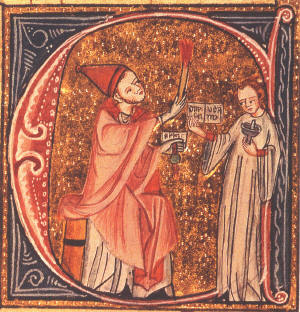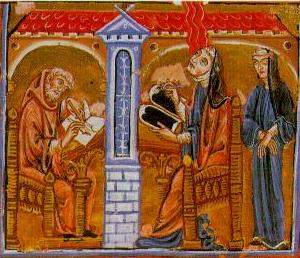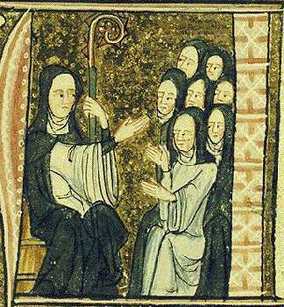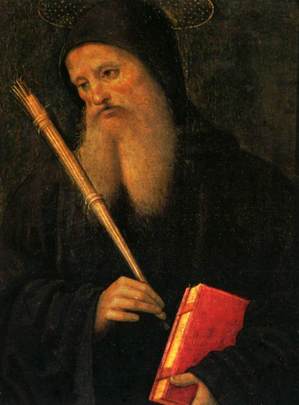 The feast of King Saint Henry (972-1024) always brings with it a keen remembrance of the commitment one makes as an Benedictine Oblate: seeking God unreservedly. The offering of oneself to God as a Benedictine oblate is a singular grace to take the gift of one’s humanity seriously as God has given it with the express desire to totally adore Him who makes us.
The feast of King Saint Henry (972-1024) always brings with it a keen remembrance of the commitment one makes as an Benedictine Oblate: seeking God unreservedly. The offering of oneself to God as a Benedictine oblate is a singular grace to take the gift of one’s humanity seriously as God has given it with the express desire to totally adore Him who makes us.
Category: Benedictine saints & blesseds
Saint Benedict
 There was a man of venerable life, Benedict, blessed by grace and by name, who, leaving home and patrimony and desiring to please God alone, sought out the habit of holy living. (entr. ant.)
There was a man of venerable life, Benedict, blessed by grace and by name, who, leaving home and patrimony and desiring to please God alone, sought out the habit of holy living. (entr. ant.)
Saint Romuald
O God, who through Saint Romuald renewed the manner of life of hermits in your Church, grant that, denying ourselves and following Christ, we may merit to reach the heavenly realms of high.
“Sit in your cell as in paradise. Put the whole world behind you and forget it. Watch your thoughts like a good fisherman watching for fish. The path you must follow is in the Psalms — never leave it…. And if your mind wanders as you read, do not give up; hurry back and apply your mind to the words once more. Realize above all that you are in God’s presence, and stand there with the attitude of one who stands before the emperor…”
Saint Romuald (+1027)
Two new Doctors of the Church: The Lord’s effective witnesses in the world
Reminding us that the Holy Spirit “continues to inspire women and men who engage in the pursuit of truth” Pope Benedict announced that on October 7, at the beginning of the Ordinary Assembly of the Synod of Bishops, he would proclaim St. John of Avila and St. Hildegard of Bingen as Doctors of the Church. “These two great witnesses of the faith lived in very different historical periods and came from different cultural backgrounds,” he said. “But the sanctity of life and depth of teaching makes them perpetually present: the grace of the Holy Spirit, in fact, projected them into that experience of penetrating understanding of divine revelation and intelligent dialogue with the world that constitutes the horizon of permanent life and action of the Church.”
The Pope continued: “Especially in light of the project of the New Evangelization, to which the Assembly of the Synod of Bishops will be dedicated, and on the vigil of the Year of Faith, these two figures of saints and doctors are of considerable importance and relevance.”
Saint Gregory VII
 The figures of the medieval period in church history
The figures of the medieval period in church history
is not high on many today. Issues of ecclesial reform and religious liberty
during the 11th century are resonant today. Liturgically the Church recalls one
of the popes who worked for reform and religious freedom: Pope Saint Gregory
VII. The Tuscan pope was born between 1020 and 1025 and bore the name of
Hildebrand. Reliable facts of his Hildebrand’s life are obscure but we know his
uncle Laurentius was abbot of a Roman monastery, where he engaged his
education. Monasteries were great centers of education and culture.
Hildegard of Bingen: the reliable witness
 Saint Hildegard of Bingen is getting some press these days. Many are very curious to know how and why the Pope did such an unusual thing in making her cult as concrete as possible. Being inscribed as a saint in the album of the saints is pretty concrete, I’d say.
Saint Hildegard of Bingen is getting some press these days. Many are very curious to know how and why the Pope did such an unusual thing in making her cult as concrete as possible. Being inscribed as a saint in the album of the saints is pretty concrete, I’d say.
The Church’s official teaching is seen by the use of concepts like “extension of Hildegard of Bingen’s cult to the entire Church,” meaning that she is proposed as a model of holiness with moral certainty to the faithful. Remember, only the Blessed Trinity is worshiped at the Liturgy. Saints and Blesseds are venerated, honored. Not the same. Hence, the definition of “cult” in Catholic theology is that the veneration saints particularly at the sacred Liturgy (i.e., the worship of God at Holy Mass, Lauds and Vespers) is made possible by the Church recognizing that this person is with God in heaven and is a reliable witness for Christian living.
For a long time Hildegard’s been called “saint.” And, so, some may say, “It’s about time” the Church made this fact official. Perhaps it wouldn’t make a difference if she was officially added to the canon of saints, but there is a certain relief that the Church has settled the cause. It has to be acknowledged that in the 800+ years since Hildegard’s death, her cause for canonization must be one of the higher profile ones around. And for whatever reason Hildegard’s cause wasn’t completed until recently. What we’ve been given by the Tradition is that Hildegard has been known as a saint, her writings, and her many ecclesial contributions are well-regarded. It is also well-known that the Pope has spoken eloquently of Hildegard a few times in the past years; hence he decided to end the ambiguity of her ecclesial status, writing her name “in the album of the saints.” Some would say that Benedict’s gesture rehabilitates Hildegard’s place in Church and state. While that may be an overstatement, he did “do good by her.”
Our newest saint is revered by the Anglo-Catholics, so this is another point of connection with those who hold the Anglican patrimony in high esteem.
You may want to read Nathaniel M. Campbell essay on his blog Fides Quaerens Intellectum.
Some things to read:
Augustine Thompson, OP, “Hildegard of Bingen on Gender and the Priesthood”
Dr. Leroy Huizenga’s First Things essay published, Hildegard of Bingen: “Saint of the Universal Church“.
On the image above: Hildegard von Bingen with Richardis von Stade (right) and Volmar (left). Miniature painting, c. 1230; Lucca, Biblioteca Statale
Pope recognizes Benedictine nun as a saint, others of the USA as having heroic virtue
This morning the Holy Father had received in a private audience Angelo Cardinal Amato, SDB, Prefect of the Congregation of the Causes of Saints, who presented the cases for sainthood that his office has been working on.
Among the many important things decided, the Pope has given us the liturgical memorial of and inscribed in the catalog of Saints of the Universal Church, the model of holiness in the person of Saint Hildegard of Bingen, a German Benedictine nun born in Bermershein in 1089 and who died in Rupertsberg on 17 Septemeber 1179.
What is interesting here is that Hildegard never really went through the same process of canonization that’s done nowadays so you can say the Church is recognizing her sanctity and place with God without the rigorous investigation that is being done for the Venerable Servant of God Michael J. McGivney. In part, this is because through the centuries the Church has changed several times, the process by which it is judged a person is a blessed or saint. Previously, people used the title “saint” with Hildegard as “popular theology and cult of the saints.”
So, with this ecclesial recognition Saint Hildegard of Bingen may be honored officially as a saint of the Church. She may be considered the Church’s newest Benedictine saint.
Saint Anselm

Saint Anselm (1033-1109) is famous for saying many things, one that is easily recalled is “I do not seek to understand that I may believe, but I believe in order to understand.” We can easily say that the Lord has give us in the person of Saint Anselm one of the most eminent figures of the Middle Ages who harmonized faith and reason. To what might we attribute this harmonization? I and some others would say it was his radical mystical experience, finely attuned sense of communio with the Trinity that oriented his thought and his action. Anselm’s contemplation and action were in sync; there was no distraction in him.
Saint Anselm knew and taught us, according to Pope Benedict, that “a true theologian’s work is divided into three stages: faith, God’s gratuitous gift to be welcomed with humility; experience, which consists in incarnating the Word of God into daily life; and true knowledge, which is never the fruit of sterile reasoning but of contemplative intuition.”
photo: Tony Bowden
Saint Benedict
Stir up in your Church, O Lord, the spirit that animated our Father Saint Benedict, that filled with this spirit we may learn to love what he loved and practice what he taught.
Today is the commemoration of the passing of Saint Benedict (known also as the Transitus of Saint Benedict). The monks of Montecassino noted the serenity of his death making him a patron, an advocate for the dying. We attribute something similar to Saint Joseph, whom we celebrated on the 19th.
Those who wear the “St Benedict Medal” will notice on the margin encircling the image of Benedict the Latin words: Eius in obitu nostro præsentia muniamur (May we be strengthened by his presence in the hour of our death)!
I might note, the Medal of Saint Benedict is THE most indulgenced medal the church has and the proper blessing of the medal contains an exorcism. Because of the Saint’s love of the Cross and his fighting of Satan, the medal has been known to protect against evil.
Tradition holds,
Six days before he died, Benedict gave orders for his tomb to be opened. Almost immediately he was seized with a violent fever that rapidly wasted his remaining energy. Each day his condition grew worse until finally, on the sixth day, he had his disciples carry him into the chapel where he received the Body and Blood of our Lord to gain strength for his approaching end.
Then, supporting his weakened body on the arms of his brethren, he stood with his hands raised to heaven and, as he prayed, breathed his last.
Pope Saint Gregory the Great, Dialogues, book 2, c. 37.
The feast celebrate today is not so much a feast about the advocacy of a good death –an important aspect of our Christian life life– as much as it is to hold before our eyes an authentic witness to Jesus Christ and His Gospel. No other saint of the Church as affected the world as Saint Benedict has.
Most holy confessor of the Lord, Saint Benedict, Father of monks and nuns, guide and intercede for the salvation of us all.
Saint Scholastica, the persistent twin sister
 As we celebrate anew the Memorial of the Virgin Saint Scholastica, we pray, O Lord, that, following her example, we may serve you with pure love and happily receive what comes from loving you.
As we celebrate anew the Memorial of the Virgin Saint Scholastica, we pray, O Lord, that, following her example, we may serve you with pure love and happily receive what comes from loving you.



